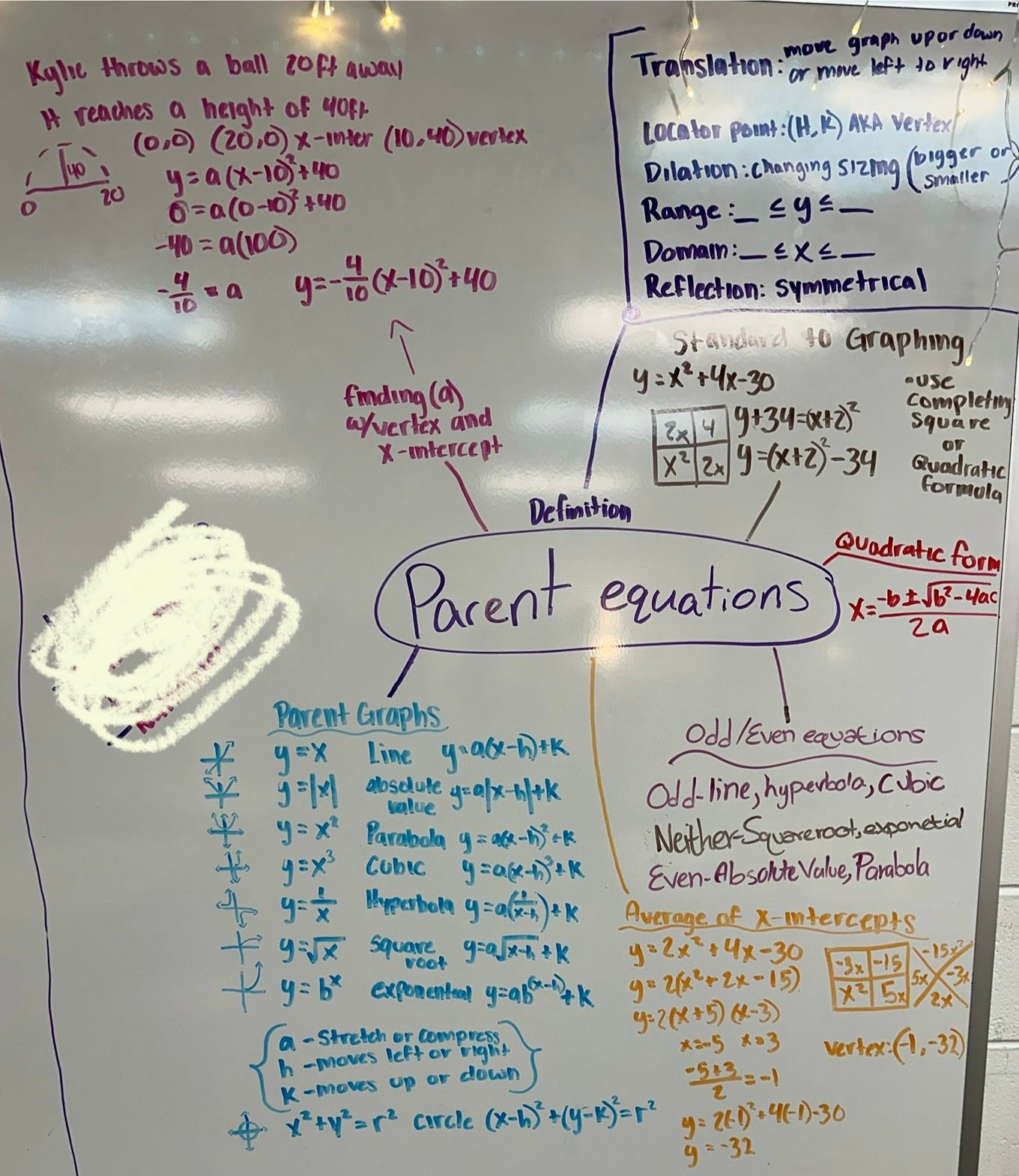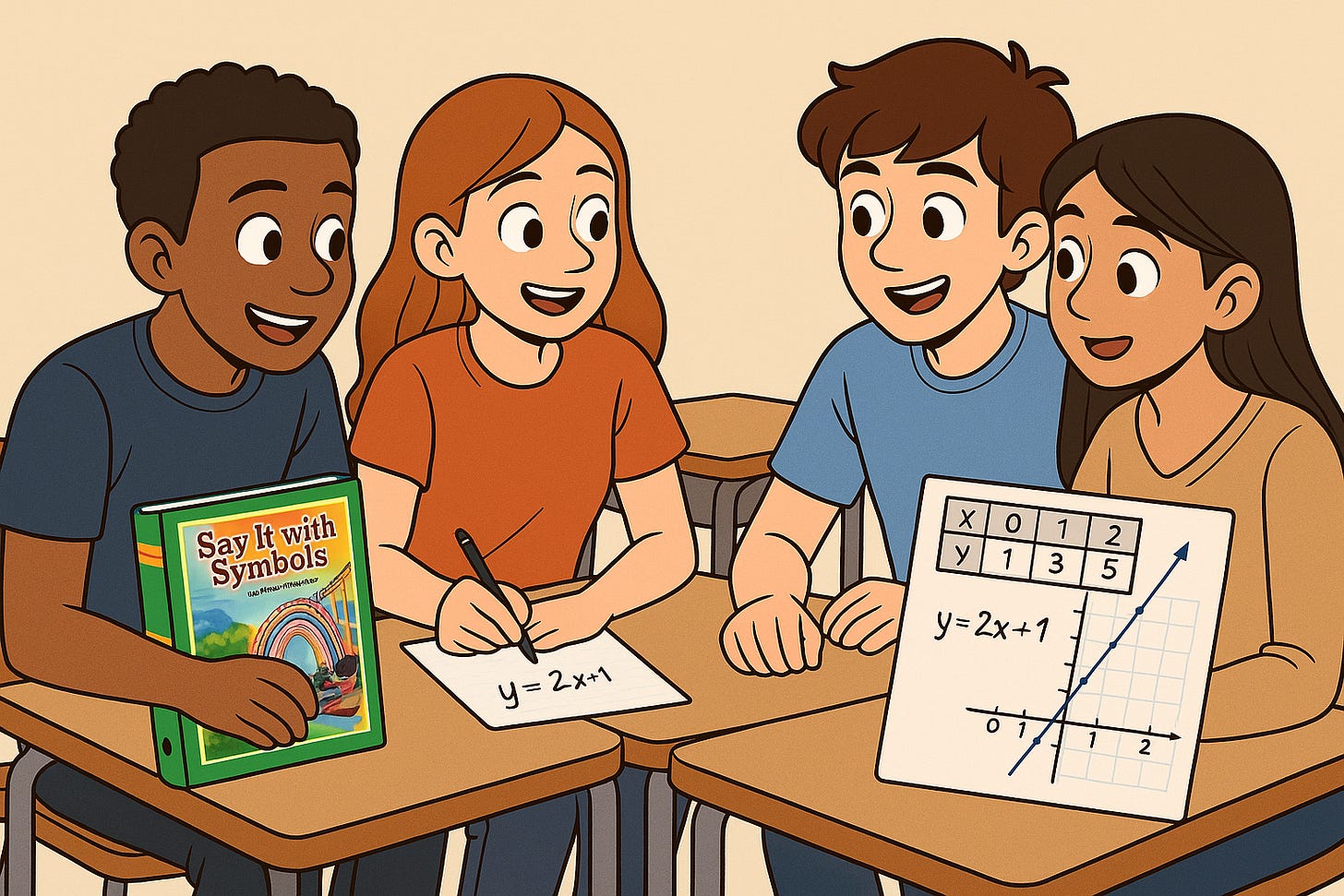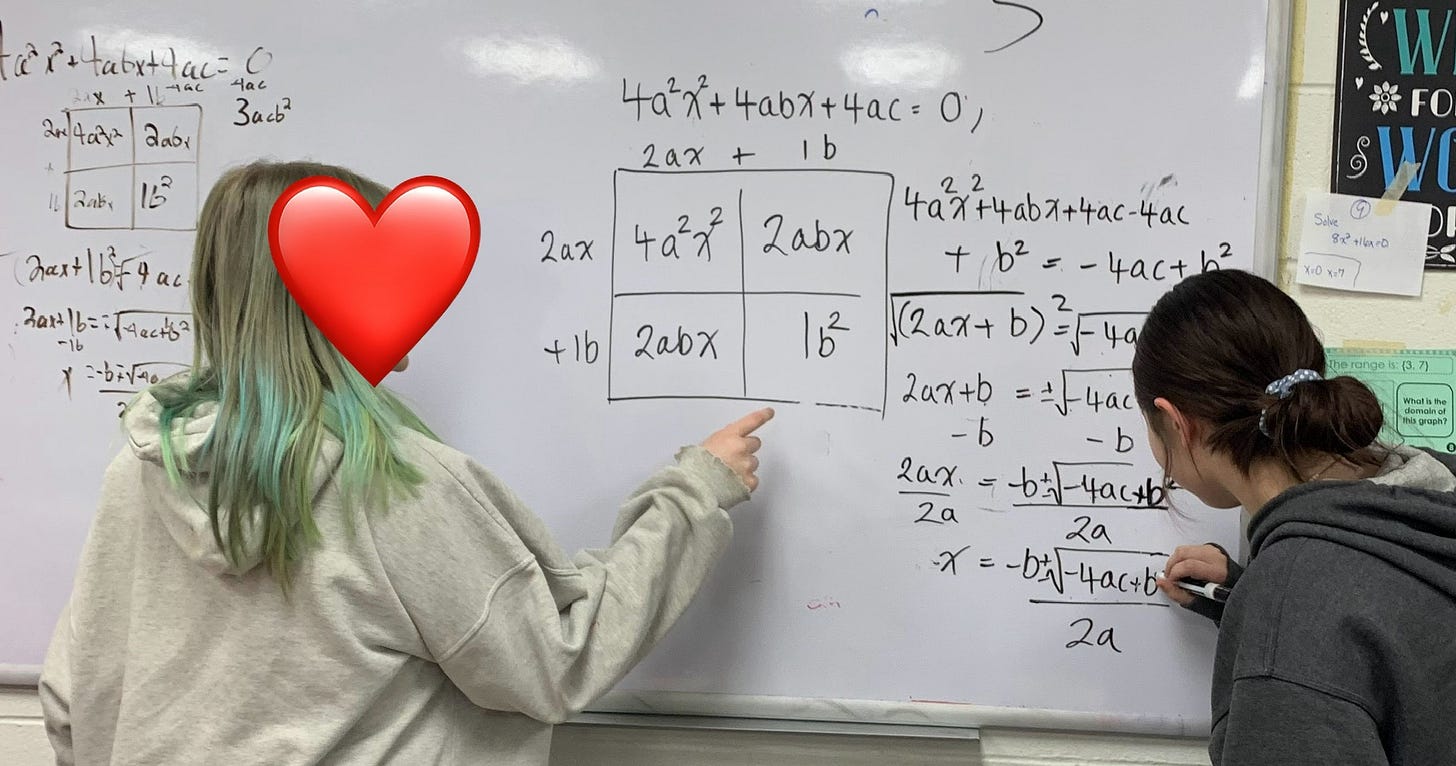At the beginning of my teaching career, I was fortunate enough to do my student teaching at a school that had adopted an inquiry-based curriculum. At that time, having students work together to solve problems that build math knowledge was a pretty radical idea. Fortunately, I had the best mentor teacher, Constance Kelly, who taught me how to inspire students to think and learn by talking about math. With her guidance, I not only learned how to teach math, I learned the reasons behind the algorithms or what I think of as “real mathematics”. I also learned that the key to teaching math is allowing students to collaborate. What I didn’t know about, until I started teaching my own classes the next year, was the amount of work it takes to guide students to work together and open their minds to think. My student teaching was during the second semester and I didn’t realize the classroom environment Connie had created before I joined the class.
During my first year of teaching, I was blessed with another great mentor, Ellen Eisele. I have no words to describe the impact Ellen made on my teaching and even though she is no longer with us, I will always remember her words of advice. “Robin, if you want students to work together you have to give them one something to answer on!” As always, she was right! If I let students answer problems on separate pieces of paper, they usually would not talk to each other. But, when I gave each group one transparency to write their answers on, they would start to talking. ( This was 1998 and a transparency is a clear plastic that teachers would write on and place on an overhead projector to project to the class.) We also had much success with students writing on poster size pieces of graph paper. Both these writing surfaces, allowed me to display the groups’ answers to the class.
“Robin, if you want students to work together you have to give them one something to answer on!” —Ellen Eisele—
Many years later, in 2022, I decided to go back to teaching after a three year break writing digital curriculum. My teacher friends warned me that teaching was not the same and that the kids were different. As most who have left teaching for a significant amount of time, I romanticized the idea of what teaching looks like and thought it would be different for me. Let me tell you it was not! I was a 21-year veteran teacher and I had never experienced a year like it and never want to again. Students were traumatized by the pandemic and acted out in various ways that I was not prepared for. One blessing that year was reading a book called Building a Thinking Classroom in Mathematics by Peter Liljedahl.
The first three, of the fourteen, practices of BTC are that students solve thinking problems, on vertical non permanent surfaces (whiteboards) in visibly random groups of three. I want to emphasize that all three of these practices are best when put together.
This book gave me a way back to teaching in a way that is best for my students, by inspiring them to think about mathematics. Unfortunately, my students didn’t know how to talk to each other about their thinking. In previous years, my students were given packets of math problems and watched their teacher show them step by step how to do each problem. While this process of show and tell was comforting to my students during the pandemic, they really didn’t understand the reasons for the steps and resorted to memorizing or mimicking. So when they came to me, they were not used to thinking and talking about math. Slowly, by working on thinking problems at whiteboards in visibly random groups, they started to talk and share their ideas and I saw joy in their faces as they talked about an idea or an answer.
The whiteboard offers a very nonthreatening surface to do math on. Students worry about making mistakes in math. Writing on a whiteboard makes erasing mistakes easy and students aren’t as worried about making them. For me, the teacher, a benefit of students writing on whiteboards is that I can see all students’ thinking at a glance. When students are writing on their own piece of paper, I have to look over their shoulders to see their work. Students can be secretive, covering their answers because they don't want me to see it. Or pretending to work. In contrast, I can easily see work on the whiteboards and make instructional decisions based on what I see.
Going back to what my mentor Ellen always knew. “Robin, if you want students to work together you need to give them one something to answer on!” Ellen is still right! Now the whiteboard is the one surface that students have to share, helping them communicate to solve problems. It is easy to spot students who are not collaborating or need help when they are standing at the whiteboard. Students can get help from other students by looking around the room to see how other groups solved the problem. This makes all students the “expert” in the room and allows me time to focus on one group at a time.
I have read criticism about how the popularity of using whiteboards is more important than the mathematics on them. In my class, I choose the math problems my students work on very carefully. Making sure that mathematics is rich. In this lesson, students are using their knowledge of of completing the square to generalize the quadratic formula.
I have tried getting students to produce the same quality work and have rich discussions sitting in groups with little success. What worked for me in the past simply doesn’t work anymore. Either one student will do all of the work while the others sit and do nothing, or each student will try to solve the problem individually. The whiteboard is a conduit that helps mathematics happen in my classroom.

Another benefit of the whiteboard is that it allows students to express themselves to me. Students are always leaving little drawings on my whiteboards helping me to connect with them. Their drawings open up a communication between us that would have never happened without a visible way for students to express themselves. My goal next year is to hang up pictures of these drawings somewhere in my classroom.
I have mini handheld white boards in my room as well and these are the preferred tool for students to “do their own math on”. The majority of my students will grab a mini whiteboard and marker to work on their assignments individually. They like that the whiteboard is easy to show work and erase mistakes as they go. They would rather write with an expo marker than a pencil.
Is math on a whiteboard better? No! Math is the same on any type of surface. However, for my students, the act of writing math on a whiteboard helps motivates them in ways that other writing surfaces simply do not and allows me the opportunity to bring rich mathematics to my students.
Thank you for helping me honor two women who had a powerful impact on my teaching by reading this article. Please feel free to share a story about someone who has impacted your teaching in the comments.
I also wanted to share that my dear friend Ellen was so loved by our community that there is a fund dedicated to help local teachers fund classroom needs in her honor. Ellen Eisele Memorial Fund







Robin was a star teacher from her first experiences in a classroom, and these blogs support her belief in continuous professional growth. She makes a point in this one that too often goes unmentioned, and that is the amount of time and effort it takes to build a positive, encouraging, and collaborative classroom culture. I often felt that my classes didn't fully "gel" until close to Thanksgiving time, but after that the learning curve was far more exponential than linear. Perhaps too often we are so eager to get to the mathematics that we ignore the emotional basis that needs to be laid and developed for real learning to occur. In many ways, a classroom is really no different than any living organism. It needs to be nurtured and embraced in order to reach its full potential. (I knew Ellen Eisele and am honored to be included with her in this piece. Such an outstanding teacher and human being, lost to us far too soon.)
Thank you Robin for your thoughtful blog. Just discovered it via Dan Meyer's recommendation. I had the good fortune of teaching for one year in 2001 in Connie Kelly's district and the times I met her she just exuded joy and positivity for teaching math. One of my colleagues, Brian, was her student teacher and he learned so much from her and we had many conversations on inquiry based learning and the methods she taught him. Thank you for bringing back those wonderful memories and it's always a good reminder on the far reach a great teacher can have not only on their students but fellow teachers as well. Really enjoy your posts. Thank you!